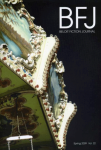There are stars aplenty in this issue devoted entirely to poetry and poetics: D. Nurske, Kevin Prufer, David Wagoner, Elton Glaser, Thomas Lux, G.C. Waldrep, Bruce Weigl, David St. John, Carl Phillips, Laura Kasischke, Franz Wright, Eric Pankey, David Hernandez, Jean Valentine, Alice Friman, Timothy Liu, Charles Wright, among others. And their work is, well, stellar. But there are equally bright and lesser-known voices on the horizon, too (many also quite accomplished and widely published), and I’d like to spotlight their contributions to this fine issue, beginning with moonlight and Melissa Kwasny’s prose poem “The City of Many Lovers.” “Moon that strikes on the downbeat,” she writes, and its Kwasny’s rhythms that are, indeed, most striking: “Lunedi. Martedi. Mercoldi. It’s moon-day.” And so she begins a poetic narrative that manages to tell a large story that unfolds in a small moment in one short lyric paragraph; it’s a perfect little model of prose poetry. Continue reading “Field – Spring 2009”

